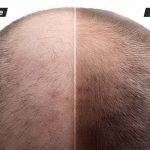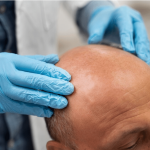Female Hair Loss Treatment: Restore Your Hair with Transplantation
Female-pattern hair loss (FPHL), known as androgenetic alopecia, is the most common form of hair loss affecting women. It’s not just about losing hair. It’s about losing a part of your identity and confidence. It typically results in gradual hair thinning, particularly around the top of the scalp and the crown, and can significantly impact self-esteem and confidence. While various treatments are available to manage FPHL, hair transplantation has emerged as a promising solution for women seeking permanent and natural-looking hair restoration.
This article will explore the causes and characteristics of female-pattern hair loss, the role of hair transplantation in addressing it, the procedures involved, and the potential benefits, risks, and critical considerations for women contemplating this treatment.
1) Comprehending Hair Loss in Female Patterns
Female-pattern hair loss is not a condition to be taken lightly. It’s a progressive condition that often starts with a general hair thinning across the scalp, particularly along the part line, and can widen over time. Unlike male-pattern baldness, which usually results in bald spots or a receding hairline, women typically experience diffuse thinning, making it more difficult to notice early on. The progression is often gradual and may worsen with age, especially around menopause, due to hormonal changes.
Key factors contributing to FPHL include:
- Genetics: Just like male-pattern hair loss, a woman’s genetic predisposition is crucial in determining whether she will experience FPHL. Understanding this can help you better manage and cope with your condition.
- Hormonal Imbalances: Hormonal fluctuations, particularly a decrease in estrogen levels or an increase in androgens (male hormones), can trigger or exacerbate hair loss. Conditions such as polycystic ovary syndrome (PCOS) and thyroid issues may also contribute.
- Aging: Hair density naturally decreases as women age, especially after menopause, when hormonal levels shift.
Unlike other forms of hair loss, such as telogen effluvium or alopecia areata, which are typically temporary or reversible, female-pattern hair loss is progressive and usually requires long-term treatment. Topical minoxidil, hormonal therapies, and nutritional supplements are commonly recommended to slow hair loss, but they rarely lead to complete restoration. This is where hair transplantation can be a more permanent solution.
2) What is Hair Transplantation?
Hair transplantation is a surgical procedure that involves transferring healthy hair follicles from one part of the body, typically the back or sides of the scalp (the donor area), to regions experiencing thinning or baldness (the recipient area). The transplanted hair is genetically resistant to hormonal changes, meaning it will continue to grow in its new location.
There are three essential methods of hair transplantation procedure:
- Direct Hair Implantation (DHITM): This method of Female hair transplantation is non-invasive and involves extracting hair follicles from a donor area and implanting them directly into the recipient area without creating incisions or channels beforehand. The process is performed using a specialized tool called a DHI Implanter, which allows precise control over each implanted follicle’s angle, direction, and depth, giving lifetime visible results.
- Follicular Unit Transplantation (FUT): Also known as the strip method, this procedure involves removing a strip of scalp from the donor area. Hair follicles are extracted from the strip and transplanted into the thinning areas. FUT is typically recommended for patients needing many grafts, but it may leave a linear scar in the donor area.
- Follicular Unit Extraction (FUE): This technique involves individually extracting hair follicles from the donor area using a specialized tool and transplanting them to the recipient area. FUE is a less invasive procedure that leaves tiny, dot-like scars rather than linear ones.
3) The Process of Hair Transplantation for Female-Pattern Hair Loss
The hair transplantation process for women follows a series of carefully planned steps to address the specific pattern and extent of hair loss. Here’s a breakdown of the procedure:
- Consultation: The first step involves a thorough consultation with a hair transplant specialist. During this consultation, the surgeon evaluates the patient’s hair loss pattern, density, and overall health of the donor area. The doctor will also discuss the patient’s goals, expectations, and concerns. Some women may not be suitable candidates for hair transplantation if their donor’s hair is insufficient or their hair loss is too diffuse.
- Pre-Surgery Preparation: Once a woman is deemed a suitable candidate, pre-surgical preparations are made. This may involve stopping certain medications or using prescribed treatments like minoxidil to optimize the scalp’s condition before surgery.
- Anesthesia and Donor Hair Extraction: In the DHITM hair transplant technique, the area from which the hair will be extracted is shaved or trimmed to make the hair follicles easily accessible. Local anesthesia is administered to the donor area to numb it, ensuring the patient feels negligible discomfort during the extraction process. A specialized punch tool (usually 0.7 to 0.9 mm in diameter) extracts the hair follicles. The tool isolates the follicle, allowing it to be carefully extracted from the scalp. The individual hair follicles are gently removed using forceps, ensuring the root and surrounding tissue remain intact for successful transplantation. Once extracted, the hair follicles are sorted and kept in a preservative solution to ensure their vitality while awaiting implantation.
- Implantation of Grafts: In the Direct Hair Implantation (DHITM) hair transplant technique, the implantation process is a refined and direct method of placing hair follicles into the recipient area. Here’s how the implantation process happens in DHI:
Advanced Implanter: The DHITM technique uses a unique tool called a DHITM implanter for implantation. This advanced device has a hollow needle where the extracted hair follicle is loaded.

Implantation: The surgeon can directly implant the hair follicle into the scalp with the DHITM implanter. This eliminates the need to create pre-made incisions or channels in the recipient area, as the pen makes the site and implants the follicle simultaneously.
Precise Angle, Direction, and Depth: The implanter allows precise control over the angle, direction, and depth of the implanted follicles, mimicking the natural hair growth pattern. This precision improves the natural look of the hair transplant.
Continuous Process: The surgeon continues this process, loading individual follicles into the implanter and inserting them directly into the scalp until the entire recipient area is covered with the desired follicles or grafts.
- Post-Operative Care: After the procedure, patients are given detailed instructions on caring for their scalp during recovery. Mild discomfort, swelling, or redness around the donor and recipient areas is joint but usually subsides within a few days. Patients may also be prescribed medications to prevent infection and reduce swelling.
4) Effectiveness of Hair Transplantation for Female-Pattern Hair Loss
Hair transplantation can be a highly effective solution for women with female-pattern hair loss, particularly for those whose hair loss has stabilized or who are not responding to other treatments. The transplanted hair is typically resistant to the hormonal changes that caused the original hair loss, meaning it should grow permanently in the new area.
Though, the success of the procedure depends on numerous factors:
- Donor Hair Availability: Women with significant thinning across the scalp may not have enough healthy donor hair to achieve the desired results.
- Extent of Hair Loss: Women with advanced hair loss may require multiple sessions to achieve optimal density and coverage.
- Realistic Expectations: Hair transplantation can restore fullness and improve appearance, but it may not have the same density as natural, unthinned hair.
5) Who is a Good Candidate for Hair Transplantation?
Not all women with hair loss are ideal candidates for hair transplantation. The best candidates are those who:
- Have localized hair thinning rather than diffuse hair loss across the scalp.
- Have sufficient donor hair in the back or sides of the scalp.
- Are in good overall health.
- Have realistic expectations about the results of the procedure.
Women with medical conditions like active alopecia areata, which causes patches of hair loss, or those undergoing chemotherapy may not be suitable candidates for hair transplantation.
6) Risks and Considerations
While hair transplantation is generally a safe and effective procedure, it does come with potential risks, including:
- Scarring: FUT can leave a linear scar, while FUE leaves tiny dot-like scars. There is no scarring in the DHITM Direct hair implantation technique. Sometimes, scars are usually hidden by surrounding hair but can be more noticeable if the hair is worn short in the FUE and FUT techniques.
- Shock Loss: Some patients experience “shock loss,” where the transplanted hair temporarily falls out after the procedure. However, this hair typically regrows within a few months.
- Infection or Poor Healing: As with any surgical procedure, there is a small risk of infection or poor healing at the donor or recipient sites. However, in the DHITM clinics specifically, all the procedures are followed by SOPs and safety protocols, and there is no risk of poor healing or infection.
- Unnatural Results: If not performed by an experienced surgeon, or done by a technician or nurses, the hairline may look unnatural, or the density may be uneven. However, in the DHI system, all the procedures are performed by highly trained and certified surgeons. No assistant or nurse technician touches the patient’s scalp.
7) Cost and Recovery
The cost of a hair transplantation procedure can vary widely based on the clinic, surgeon’s experience, location, and number of follicles or grafts needed. On average, hair transplant procedures for women can range under a few thousand dollars.
There is no downtime when the DHITM surgeon uses the DHITM technique to perform the hair transplant procedure. In other hair transplant techniques, the recovery from a hair transplant typically takes a few days to a week. Most patients can return to normal activities after weeks, although avoiding strenuous exercise for at least two weeks is essential. The newly transplanted hair will go through a shedding phase before growing again, with final results becoming visible after 10 to 15 months.
Hair transplantation offers a promising and permanent solution for women with female-pattern hair loss. With advanced techniques like DHITM, and direct hair implantation technique, women can achieve natural-looking results that restore hair density and confidence even when un-shaving their scalp. However, choosing a qualified surgeon, understanding the risks, and maintaining realistic expectations about the outcome are essential. A hair transplant can provide a cosmetic improvement and a renewed sense of self-assurance for women struggling with the emotional and physical impact of hair loss.
What is the DHI Hair Transplant Procedure?
DIRECT HAIR IMPLANTATION (DHITM) – DHITM is a unique hair transplant procedure that can only be performed by:
- DHITM Technique
- DHITM certified doctors
- DHITM protocols
- DHI’s patented instruments
- At DHITM authorized clinics
No pain, no scars, no downtime. The perfect natural result every single time.
Why choose a hair transplant treatment at the DHI clinic?
DHITM technique and its benefits are propriety to DHI Medical Group. Some clinics and doctors try to copy this and claim to use the DHITM technique, which is misleading. The following features are only available at DHI-authorised clinics.
1) We are proud to be ranked #1 in customer satisfaction in a hair transplant industry survey by IMRB. Our customer satisfaction rate is more than 99%. Also, they received the Customer Excellence Award from Quantic and numerous other awards and accreditations from medical bodies worldwide.
2) Our results are not just good; they are fantastic! Click LINK to see our results and LINK for our customer feedback.
3) We provide hair restoration services for men and women with all stages of hair loss. This includes high growth factor PRP/GFC therapies and Activa Regenera treatment for early-stage alopecia, hair transplants for all stages of alopecia, and the highest-quality natural human hair cosmetic patches for very advanced stages of alopecia. Our hair loss treatment products and nutraceuticals have the highest-grade active ingredients, and you can shop for them here.
4) All procedures are performed from start to finish by DHITM doctors trained and certified by the London Hair Restoration Academy. The surgeons are focused on hair restoration procedures only. Every procedure undergoes strict quality control.
5) All procedures are performed per strict standard operating protocols accredited with the UK Care Quality Commission and ISO standards.
6) The world’s safest hair transplant procedure is performed in a sterile environment according to comprehensive safety protocols. All procedures are performed only after proper diagnosis and medical tests.
7) Our patented implanter allows Perfect control over angle, depth, and direction. Only the highest-quality imported instruments are used and discarded after every procedure.
8) One-step implantation to ensure minimal graft handling. The highest graft survival rate is over 90%, compared to 50-90% in other clinics.
9) There are no stitches, pain, scarring, or downtime. You can return to work the next day. It is just a short procedure to regrow your hair naturally and permanently. Daily Mail UK titled DHI the “Lunch Hour Transplant” (click here to read the article).
10) Achieve strong density in a session compared to other low-density techniques such as FUE and FUT.
11) Natural Results Guaranteed – The DHITM technique gives you a perfectly natural result; others will only know you had a transplant if you tell them.
12) DHI is the world’s largest hair restoration medical group from Greece. For more than 50 years, we have focused on research, innovation, and education in hair restoration. We have 75 clinics in 45 countries serving more than 5,00,000 satisfied customers. Top celebrities from the entertainment, sports, business, and politics only trust DHI for their hair restoration.
7 Key questions you should ask before choosing your hair loss solution
- Who will perform the procedure?
In most clinics, procedures are performed by technicians only. The clinic owners are plastic surgeons and dermatologists mainly involved in sales and marketing. Their involvement in the actual procedure is very limited. You should go to a clinic where a doctor performs the entire procedure himself/herself, not through a technician.
It is also important to check if the clinic/doctor specializes in hair transplants or offers other aesthetic treatments, such as Botox. A better choice would be to go for a super specialist doctor.
- Is your doctor suitably trained and certified? Do they follow standard and accredited protocols?
In most cases, doctors learn hair transplants from other doctors without any evaluation or certification process. This can take years for them to learn the intricacies of hair transplants. Further, most doctors do not follow any written protocols and perform procedures based on personal preferences, leading to sub-optimal results.
Please check if the doctor performing the procedure has training and accreditation from a reputed institute. Very importantly, personally verify if the clinic has written protocols for all stages of the hair transplant procedure, including detailed safety protocols.
- What is the experience of the clinic/doctor you are going to?
Hair transplant is a relatively new area of practice, which has lured many doctors to leave their practice in the field of their expertise and move towards hair transplants only in the last 3-5 years. Many clinics may not have the experience, protocols or the necessary expertise to handle hair transplant cases. Please ensure that the clinic has been established for many years and has a verifiable reputation. Do not just rely on what they claim.
- How does the clinic ensure the quality of your results?
Research shows that on average only half of the implanted hair may grow in certain clinics without proper experience. This is because the clinic may not have access to the latest techniques, instruments, tools, protocols, etc. Please stay away from freelancers who work in many clinics on a case-by-case basis. They are most likely to spoil your case as they may care least for the patient. Sometimes the doctor may be very qualified or experienced but past his prime to be able to give good results.
Do check if the work done by the doctor is supervised by someone. Does the doctor follow any certification, assessment, and quality monitoring process? It is not advised to go to a clinic where there is only one doctor whose work goes unsupervised.
Good results can only come with right technique, instruments, tools, protocols, training, assessment, and quality control.
- How do you ensure your safety during and after the hair transplant procedure?
Generally, hair transplant is a safe process and cannot lead to severe risks. However, sometimes there could be scalp infections or even more severe conditions if the correct safety protocols are not followed. This risk is very high when procedure is performed by technicians or inexperienced doctors.
You are advised to ask relevant questions and see the written safety protocols at the clinic.
Please see the procedure room and ask yourself if you feel confident about the safety protocols.
- Would you go for a hair transplant without a proper evaluation of your alopecia?
The answer is obviously No. There are 10 kinds of alopecia. Unless a proper diagnosis is carried out, the correct treatment cannot be recommended. Many clinics recommend hair transplants without making a proper diagnosis. They also may not conduct a mathematical count of the donor and recipient areas to give a correct assessment of the hair transplant requirement and feasibility. Please invest time and effort during your diagnosis and evaluate the doctor on proper diagnosis of dermatological examination, precise hair count of donor and recipient area, and computerized alopecia test. This results in a comprehensive lifetime treatment plan and the best results for your hair loss problem.
- Should price play a role in choosing a hair transplant clinic or doctor?
Yes, of course, price is indeed a very important criterion. But you should not choose a clinic or doctor purely on the cost. Many doctors are able to reduce their costs significantly by reusing the instruments, compromising on safety standards, using technicians to do the procedures, etc. Quality and Safety come at a price. This is your investment in your safety and great-looking results for life. So choose wisely.






